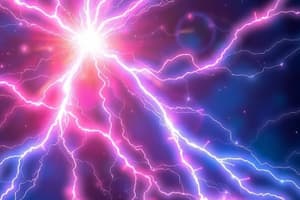Podcast
Questions and Answers
What is the phenomenon where voltage arises from changes in a magnetic field caused by varying current flowing through a conductor?
What is the phenomenon where voltage arises from changes in a magnetic field caused by varying current flowing through a conductor?
- Electromagnetic radiation
- Static electricity
- Ohm's Law
- Electromagnetic induction (correct)
What type of force can produce unidirectional motion and is caused by the interaction of moving charged particles with magnetic fields?
What type of force can produce unidirectional motion and is caused by the interaction of moving charged particles with magnetic fields?
- Magnetic force
- Frictional force
- Gravitational force
- Lorentz force (correct)
Why do magnets attract each other across empty space?
Why do magnets attract each other across empty space?
- Due to gravitational force
- Because both have circulating electron currents (correct)
- Due to Lorentz force
- Because of Ohm's Law
Which law describes the relationship between current, voltage, and resistance in an electrical circuit?
Which law describes the relationship between current, voltage, and resistance in an electrical circuit?
What does electromagnetic induction allow us to generate using mechanical means like rotating magnets or electromagnets?
What does electromagnetic induction allow us to generate using mechanical means like rotating magnets or electromagnets?
What does Ohm's Law connect in electrical circuits?
What does Ohm's Law connect in electrical circuits?
Which formula represents Ohm's Law?
Which formula represents Ohm's Law?
How are magnetic field lines described?
How are magnetic field lines described?
What does magnetic flux density denote?
What does magnetic flux density denote?
How is the intensity of a magnetic field measured?
How is the intensity of a magnetic field measured?
Which region of a magnet exhibits higher magnetic field strengths?
Which region of a magnet exhibits higher magnetic field strengths?
Flashcards are hidden until you start studying
Study Notes
Magnetic Field and Current: Understanding Electrical Phenomena
Underlying various aspects of our daily lives—from powering electronic devices to guiding navigation systems—are two fundamental concepts: magnetic fields generated by electric currents and the behavior of those fields themselves. In this exploration, we'll dive into how these principles intertwine through electromagnetic induction, magnetic forces, the familiar Ohm’s Law, magnetic field lines, and magnetic field strength.
Electromagnetic Induction
Electromagnetic induction is a phenomenon where voltage (or electricity) arises from changes in a magnetic field caused by varying current flowing through a conductor such as a wire loop or coil. This process allows us to generate electrical energy using mechanical means like rotating magnets or electromagnets within alternators and generators.
Magnetic Forces
When electric charges move along conductors carrying a current, they create magnetic fields around them. These moving charged particles experience their own magnetism and interact with other magnetic fields causing what we call Lorentz force, which can produce unidirectional motion called motional EMF (electromotive force). Consequently, magnets attract each other across empty space because both have circulating electron currents resulting in oppositely directed magnetic fields.
Ohm's Law
Ohm's Law connects the three primary variables associated with electrical circuits: resistance ((R)), voltage ((V)), and current ((I)). It states that (V = I \times R), meaning if you increase the current in a circuit while keeping everything else constant, the voltage will also increase proportionally. While it doesn't directly relate to magnetic fields, understanding Ohm's Law helps grasp the relationship between the magnetic effects of current and other facets of electricity.
Magnetic Field Lines
Magnetic field lines help visualize the nature of magnetic fields. They appear as continuous curves that start on the north pole of a magnet and end on its south pole without crossing each other. Field lines serve as guides illustrating the direction in which the magnetic field exerts forces upon objects (e.g., ferromagnetic materials) placed inside the magnetic field.
Magnetic Field Strength
The intensity or magnitude of a magnetic field is denoted as magnetic flux density, expressed in terms of the magnetic field strength ((B)) measured in units like tesla (T), gauss (G), or newton per ampere meter ((\frac{N}{A m})). A stronger magnetic field implies more intense repulsion or attraction forces experienced when placing ferromagnetic objects within the field. For instance, regions closer to the centerline of a bar magnet exhibit higher magnetic field strengths compared to areas further away due to the concentration of magnetic lines of force in these central zones.
These five essential points offer a foundation for understanding the relationship between current and magnetic fields. As you continue your study of these phenomena, you will find yourself marveling at the intricate dance of forces driving advancements in technology today.
Studying That Suits You
Use AI to generate personalized quizzes and flashcards to suit your learning preferences.




